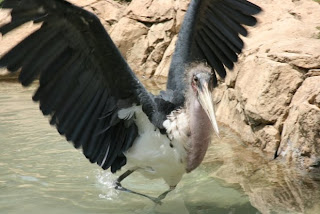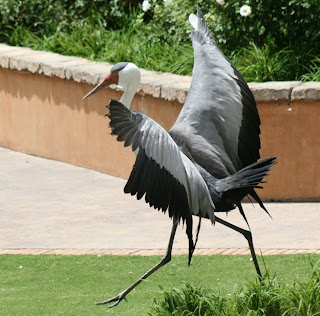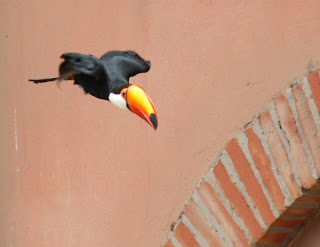To the casual observer the massive Marabou Stork with its balding, scabby head and pendulous pink air sac may appear to be one of the ugliest creatures in the world. If this same observer were to notice the Marabou's fondness for carrion and its habit of squirting excrement onto its own legs he or she would probably consider the original opinion to be justified. It takes a real bird lover to see past all of this stork's bizarre adornments to recognize the scruffy charm underneath.

A large male Marabou Stork, standing up to 1.5 m tall and weighing nearly 9 kg, is one of the largest flying birds in the world. Their wingspan approaches 2.9 m. Females are generally smaller.
Marabou's evolved their naked heads and necks as an adaptation for feeding on large animal carcasses without getting their head feathers soiled with blood and gore. More than 200 Marabous were seen feeding on a single elephant carcass in Kruger National Park. They rely on vultures and other scavengers to open the tough outer hides and then use their cleaver-like bills to retrieve and then swallow surprisingly large pieces of meat. They are not above stealing morsels from other smaller scavengers.

Marabou Storks will eat just about any kind of animal, dead or alive. Living prey includes termites, fish, locusts, grasshoppers, army-worm caterpillars, frogs, rodents, crocodile eggs and hatchlings, quelea nestlings, doves, young and adult flamingos, cormorant nestlings, and pelican chicks.

The principal food of the Wattled Crane is aquatic vegetation, including the tubers and rhizomes of submerged sedges and water lilies. In particular, Wattled Cranes depend heavily on the sedge Eleocharis spp. In dryer upland habitats, Wattled Cranes forage for grain, grass seeds, and insects, and they make use of agricultural fields when convenient.
In Ethiopia, Wattled Cranes take advantage of beetle larvae and other invertebrates that occur in the spoil heaps created by the giant molerat!

The Toco toucan is at home in South America's tropical forests but recognized everywhere. The toucan's oversized, colorful bill has made it one of the world's most popular birds.Their average lifespan in the wild: Up to 20 years.

The 7.5-inch-long (19-centimeter-long) bill of both sexes is made of the same substance as you finger nails and is used to catch tasty morsels and pitch them to one another during a mating ritual fruit toss. In addition to fruit, they eat insects and, sometimes, young birds, eggs, or lizards.

Toucans nest in tree holes. They usually have two to four eggs each year, which both parents care for. Young toucans do not have a large bill at birth—it grows as they develop and does not become full size for several months.


No comments:
Post a Comment